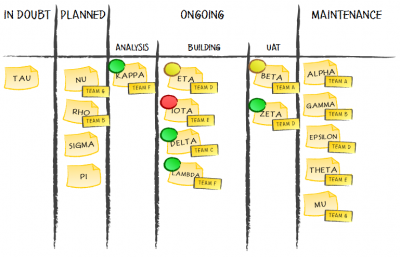When applying Kanban on project portfolio level you’re dealing with different challenges than in case of standard Kanban implementation on a team level (if there even is such a thing). Both the flow dynamics and task granularity is very different, thus you need to focus on different aspects when designing Kanban board.
This is basically why typical Kanban board design will often be suboptimal.
At the same time the biggest challenge you face on project portfolio level is defining and applying WIP limits. For the time being my thoughts on a subject are that depending on a specific environment teams would be choosing very different measures to manage WIP on portfolio level. However, as we as a community still lack experience from addressing different scenarios I’ll focus on the path I’m following. After all the story format I chose requires that.
In my case the most reasonable thing I was able to come up with was a number of people involved in project work. Unfortunately the scale of the team (more than 130 people) didn’t allow me to use straightforward approach and scale up WIP limits with numbers.
Instead of continuing my struggle to find a perfect measure that suits the current board I decided to redesign it completely.
Whenever you read about Kanban you learn that it is an evolutionary approach. Kaizen and all the stuff. However one advice I have on designing a Kanban board in general is that when you start running circles with board evolution and see little or no improvements throw the whole board out and start from scratch. From one point of view it can be considered a revolution (kaikaku) but from another: you don’t really change your way of working, you just try to visualize it differently.
Either way I took my own advice and started from a clean whiteboard. I also remembered another advice: not to stick to standard board designs. This is what I ended up with.
First, there is no value stream or process in a way we understand it on a team level. Since the flow of index cards wasn’t dynamic I decided this isn’t information I should focus on that much.
Second, on horizontal axis, instead of process there is a time line (monthly granularity). As variability of project sizes is huge I decided I need some sort of time boxes which I measure WIP against. With very few small engagements, ones that take us less than a few weeks, monthly time boxes looked reasonable.
Third, I created swim lanes for teams. We don’t have 130 generic engineers, or Average Full-Time Equivalents, or whatever other inhumane label you can think of. We have teams that we strive to protect and teams do have specializations. It means the context of a team is very important and if it is important it goes to the board, thus swim lanes.
Fourth, having such board construction I had to change my approach to index cards. Instead of having a single index card representing single project I ended up with territory-driven approach. A project covers a territory both in terms of team(s) and time. Looking at index cards with a project name you can instantly guess which team is working on the project and how long it’s going to take them. And the best part: a size of index card in any given month represents roughly how big part of a team would be involved in work on a project. This way we can easily show a few smaller projects as well as on big or any combination of those two.
Fifth, as one of Kanban base concepts is pull it is represented by backlog area – green cards on the left side of the board. These are projects that aren’t yet started. The specific swim lane they are neighboring show preferable team to work on a project. However, it rarely is such a direct dependency: this team will do the project as there is no other one suitable to do the job. Most of the time we assume that another team can build the project too. Each time a project goes into development we decide, at last responsible moment, which team will take it.
Of course there are some nice additional flavors here as well. Violet and yellow index cards differentiate maintenance projects from new ones. Green card are for projects that aren’t yet started and once they are we switch to yellow. Red index cards represent overrun in projects that are late. As we work on fixed price, fixed time projects we roughly know up front how much time and people we want to invest into a project. When something bad happens and this plan changes we show that. After all we put more attention to challenged projects.
A simple fact that we are working on fixed time, fixed price projects doesn’t mean our arrangements never change. They do. Any time something changes we just update it on the board, same as we’d do with any other board. We just keep the board updated as other way its value would diminish.
This Kanban board design definitely tells more than the initial one but I started this whole revolution to deal with WIP limits. What with them?
Well, there still aren’t explicit WIP limits. However at this moment there are implicit WIP limits and information about them can be pretty easily extracted. Considering that I use territory-driven approach to index cards WIP limit is show by vertical axis of the board. Each team has a limit of one full-sized sticky note (representing whole team) per month which can be split in any way.
In other words we won’t start another project unless there’s some white space that this project would fit into as white space represents our spare capabilities. Actually, it may be a bit of simplification as on rare occasions there are project we just start, no matter what. But even then we either can make such project fit the white space in a reasonable way or we need to make some more white space for it.
Even though such WIP limits aren’t explicit, after some time of working with the board I can tell you they do the job. They do, not only in pulling new projects into development but also, and more importantly, in long-term planning as we have visibility a year ahead and can confront our capabilities with planned sales etc.
With this board, for the first time from the beginning of my journey with project portfolio Kanban I felt satisfied.
See how we come up to this point – read the whole story.
Advertisement: Infragistics® NetAdvantage® for Windows Phone gives you rich, innovative mobile UI controls to build high-end mobile user experiences for Microsoft® Windows Phone®. Their high performance, eye-catching data visualizations, mobile form factor optimization, touch gesture support, and alignment with Metro usability guidelines take your social media connected mobile applications to the next level.



Leave a Reply